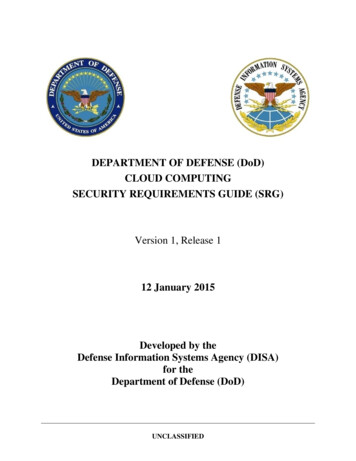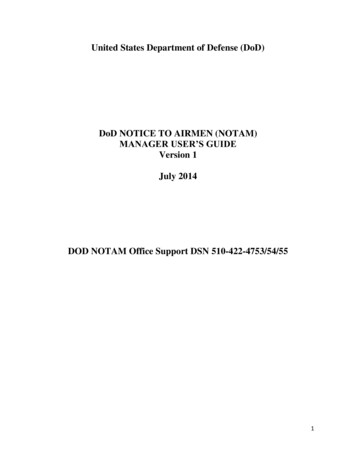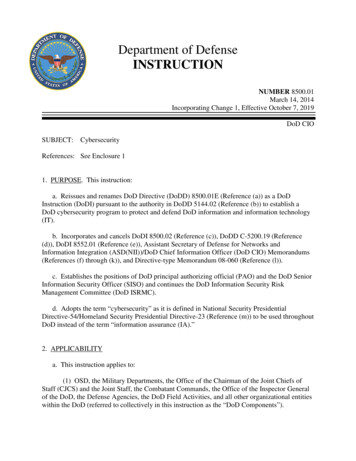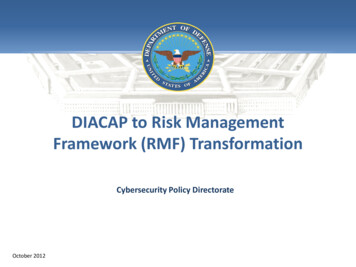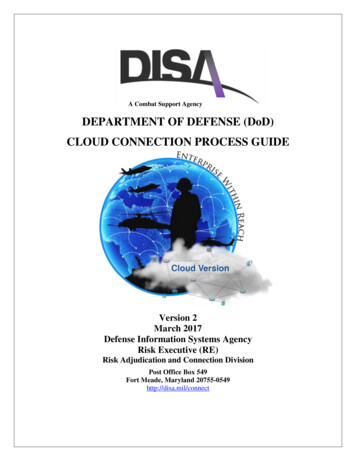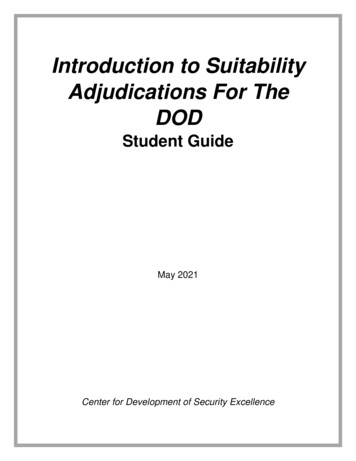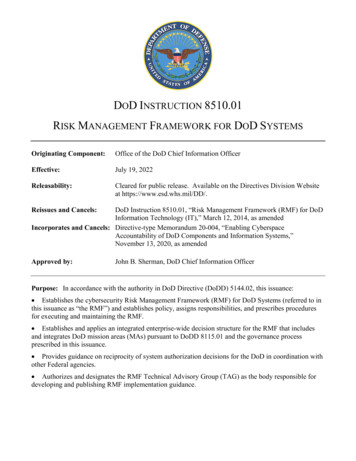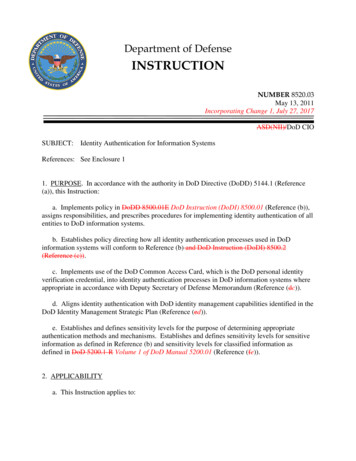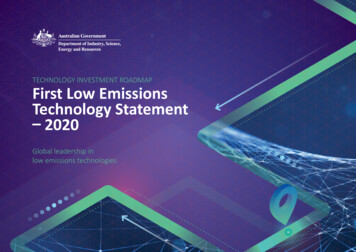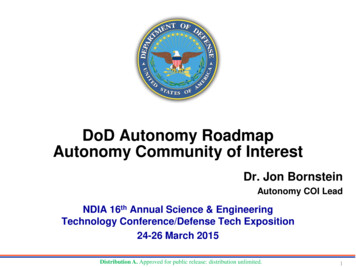
Transcription
DoD Autonomy RoadmapAutonomy Community of InterestDr. Jon BornsteinAutonomy COI LeadNDIA 16th Annual Science & EngineeringTechnology Conference/Defense Tech Exposition24-26 March 2015Distribution A. Approved for public release: distribution unlimited.1
OutlineOverview of the Autonomy COI Setting the Stage COI purpose & steering group Autonomy DriversAutonomy Portfolio MRPI, HASIC, STAS, TEVV ARPIIndustry Opportunities Enduring gaps Defense Innovation MarketDistribution A. Approved for public release: distribution unlimited.2
Setting the StageDefense Science Board July 2012 Task Force ReportAutonomy is a capability (or set of capabilities that enables a particularaction of a system to be automatic or, within specified boundaries“self-governing.” The DoD should embrace a three facet autonomous systems framework Cognitive echelon – scope of control Mission timelines – dynamic redistribution of responsibility Human-machine trade spaces Structure autonomous systems acquisition programs to separate autonomysoftware from the vehicle platform Create developmental and operational test and evaluation (T&E) techniquesthat focus on the unique challenges of autonomyNeither Warfighter nor machine is truly autonomousDistribution A. Approved for public release: distribution unlimited.3
Breadth of AutonomyAir, Land, Sea, Cyber, Non-Physical SystemsSpaceAirCyberLandSeaDistribution A. Approved for public release: distribution unlimited.4
Autonomy Community of Interest (COI)Purpose: Closely examine the DoD’s S&T investments in the enabling of autonomoussystems, to include the strategic assessment of the challenges, gaps, and opportunitiesto the development and advancement of autonomous systems, and identification ofpotential investments to advance or initiate critical enabling technology development.The Autonomy COI provides a framework for DoD scientists, engineers, and acquisitionpersonnel to: Engage in multi-agency coordination and collaborationReport on the "state-of-health"Identify emerging research opportunitiesMeasure progressAutonomy COI Steering Group:Distribution A. Approved for public release: distribution unlimited.5
Technology PortfolioWhat’s driving Autonomy S&T? Manpower efficiencies (reduce human footprint and personnel cost)Rapid response and 24/7 presence (timely, persistent, enduring)Harsh environments (day, night, hot, cold, bad weather, rubble, barriers)New mission requirements (increasing competence enables new capabilities)Advanced medical applications (critical response, end-to-end critical care)Logistical support (reduce logistics burden: hold, transport, carry, watch)Technology Taxonomy (Tier 1)Machine Perception, Reasoningand IntelligenceScalable Teaming ofAutonomous SystemsHuman/Autonomous SystemInteraction and CollaborationTest, EvaluationValidation and VerificationDistribution A. Approved for public release: distribution unlimited.6
Tier 1Brief DescriptionsMachine Perception, Reasoning and Intelligence (MPRI):Perception, reasoning, and intelligence allows for entities to have existence, intent,relationships, and understanding in the battle space relative to a mission.Human/Autonomous System Interaction and Collaboration (HASIC):The keys to maximizing the human-agent interaction are: instilling confidence andtrust among the team members; understanding of each member’s tasks, intentions,capabilities, and progress; and ensuring effective and timely communication. All ofwhich must be provided within a flexible architecture for autonomy; facilitatingdifferent levels of authority, control, and collaboration.Scalable Teaming of Autonomous Systems (STAS):Collaborative teaming is a fundamental paradigm shift for future autonomoussystems. Such teams are envisioned to be heterogeneous in size, mobility, power,and capability.Test, Evaluation, Validation, and Verification (TEVV):The creation of design based verification and validation (V&V) methods and noveldevelopmental and operational test and evaluation (T&E) techniques that focus onthe unique challenges of autonomy, including state-space explosion, unpredictableenvironments, emergent behavior, and human-machine communication.Distribution A. Approved for public release: distribution unlimited.7
Autonomy S&T FundingDistributionsTotal 149MCOI Sub-Areas ( M) 3 9Autonomy - General 13Human & AutonomousInteraction and Collaboration 73 51DoD PB15 FY 2015MachinePerception, Reasoning, IntelligenceScalable Teaming ofAutonomous SystemsTesting, Evaluation, V&VBy Component Investment5%28%13%Air ForceArmyNavy25%29%DARPAComponentsBy Budget Activity Funding across DoD inAutonomy Autonomy appears acrossmany COI’s Based on FY15 PresidentialbudgetDistribution A. Approved for public release: distribution unlimited.8
Machine Perception Reasoning &Intelligence (MPRI)Goals:Central Technical Challenge:Common Representations/Architectures Development of a common construct ofknowledge for all entities in the mission space.Knowledge may be represented in a proceduralformat and/or in a format that can be analyzedand decomposed independent of its contentthrough inference.Theunderlyingperceptual, reasoning, and learningcapabilities to greatly reduce the need forhuman interventions, while enablingeffective teaming with the warfighterHighly Capable Unmanned System:Learning and Reasoning Development of methods for entities to evolvebehaviors over time based on a complex andever-changing knowledge base of the battlespace.Understanding the Situation/Environment Development of methods for sharedunderstanding amongst entities of the battlespace in the context of mission, backgroundknowledge, intent, and sensor information.Robust Capabilities Fundamentally explore system paradigms toensure behavioral stability in the face ofincreasing complexity and uncertainty. This isespecially important in implementation.Co-leads: Greg Hudas, TARDECJim Overholt, AFRLDistribution A. Approved for public release: distribution unlimited.10
Machine Perception Reasoning &Intelligence (MPRI)Technology Trends (Evolving): Near Term: Development and use of ontologies to enablebehavior development Utilization of supervised learning dependent uponcreation of significant corpus of sample data Object/behavior classification at less than “realtime” Automation of low-level behaviors Model-Free analytics of data basesCentral Technical Challenge:Theunderlyingperceptual, reasoning, and learningcapabilities to greatly reduce the need forhuman interventions, while enablingeffective teaming with the warfighterHighly Capable Unmanned System: Far Term: Ontologies adjusted through common-senseknowledge via intuition. Learning approaches based on self-explorationand social interactions. Shared cognition Behavioral stability through self-modification. System self-awarenessCo-leads: Greg Hudas, TARDECJim Overholt, AFRLDistribution A. Approved for public release: distribution unlimited.11
Machine Perception Reasoning &Intelligence (MPRI)Central Technical Challenge:Hard Problems: Learning context, adaptive recognition and sceneunderstanding to semantic level for presentation to asystem or person Processing of sensor data to information to actionableunderstanding presented to the warfighter and thesystem to include multiple warfighters or entire system Autonomous systems that appropriately use internalmodel-based/deliberative planning approaches andsensing/perception driven actions/controlTheunderlyingperceptual, reasoning, and learningcapabilities to greatly reduce the need forhuman interventions, while enablingeffective teaming with the warfighterHighly Capable Unmanned System: Representations that support perception andintelligent behavior Autonomously adjudicate between behaviors, e.g.,wide area exploration and exploitation of area, entity,sensing modality, etc.Co-leads: Greg Hudas, TARDECJim Overholt, AFRLDistribution A. Approved for public release: distribution unlimited.12
MPRI: Robotics CollaborativeTechnology Alliance312Engineering display screen shot from recent experimentRecent AccomplishmentsDescription: Conducts research inperception, learning and reasoning, human-robotinteraction, manipulation and unique mobility toachieve greater levels of autonomous behaviorand mobility for future unmanned systems; aimto unburden the soldier and enhance situationalawarenessCurrent Status: Initial instantiation of a hybridarchitecture has been created and integrated on asmall commercial platform.Approach: Instantiated hybrid cognitive/metric architecture to Advance capabilities in five fundamental (multifacilitate teaming of soldiers and robotsFY 12 FY 13 FY14 disciplinary) technologies: hybrid cognitive-metricarchitecture, learning, semantic perception, behavior Developed behavior descriptions based upongeneration, & shared (human-machine) mental model ofexperience with natural language constructsthe environment . Created algorithms for semantic labeling of objects Employ extensive modeling and simulationand behaviors, extensive use of supervised andto prove component technology, explore integratedunsupervised learningcapabilities Conducted laboratory demonstration of active Conduct structured live experimentation to assessLADAR sensingperformance and validate M&S resultsDistribution A. Approved for public release: distribution unlimited.13
Human/Autonomous System Interactionand Collaboration (HASIC)Goals:Central Technical Challenge:Calibrated trust: Collaboration means there must be anunderstanding of and confidence in behaviors anddecision making across a range of conditions.Agent transparency enables the human tounderstand what the agent is doing and why.Shared perception, understanding &collaborationTrusted Autonomous Systems:Common understanding and shared perception: For humans and agents to have sharedunderstanding, perception, and situationalawareness, data and information must be incommon representations and transmittable indiscernible formats and timescales.Human-Agent Interaction: The environment must allow for fluid, freeflowing, and prompt interactions. Hand-off of taskexecution and decision making must be gracefuland flexible. The “system” (both human andmachine) must be able to adjust the level ofauthority and decision-making based on themission situation and relative performance.Co-Leads: Alan Schultz, NRLWill Curtis, AFRLDistribution A. Approved for public release: distribution unlimited.14
Human/Autonomous System Interactionand Collaboration (HASIC)Technology Trends:Central Technical Challenge:Near Term Improved Human-MachineCommunication Improved machine understanding ofvoice & gesture Employment of abstract representations Requires appropriate data sets Desire for Transparency/accountabilityShared perception, understanding &collaborationTrusted Autonomous Systems: Mid Term Improved methods for sharing ofauthority Employs static measures of effectivenessto assess performance Far Term Context aware interaction Awareness of “commanders intent” Use of indirect feedback mechanismsCo-Leads: Alan Schultz, NRLWill Curtis, AFRLDistribution A. Approved for public release: distribution unlimited.15
Human/Autonomous System Interactionand Collaboration (HASIC)Hard Problems:Central Technical Challenge: Shared perception, understanding &collaborationNatural modes of communication (bidirectional) between human and machine Maintain warfighter situational awareness “Converse” in the warfighter’s languageTrusted Autonomous Systems: Cognitively compatible behavior Common ground – understanding of theenvironment: physical, social/behavioral Transparency – ability to understand teammateactions Recognition of activity; recognition ofchange/exceptions; recognition of deception Understanding commander’s intent Dynamically changing level of interaction Recognition that relative levels of competencyfor humans and machines is dynamic – howdoes the system (human & machine) smoothlytransitionCo-Leads: Alan Schultz, NRLWill Curtis, AFRLDistribution A. Approved for public release: distribution unlimited.16
HASIC: Human Insight and TrustTechnology Development Plan (FY)PriorIn-house Research Complacency Studies Human-Machine teaming methods Suspicion Studies Trust Pedigree Studies Pilot Robot Control StudiesNASA Experiments Transparency MethodsAuto GCAS Field StudyHuman-Robot Dialogue Study14151641744DescriptionDELIVERING: Design principles, assessment methodology,concept evaluation & testingResearch centered on human-machine teaming elementsof trust calibration, transparency, and trust-based biasesin humans-machine contexts.Benefits to the Warfighter Validated design principles for fostering transparency inhuman-machine teaming contextsTechnology Validated assessment metrics and methods for human Human-machine teaming metrics/methods for evaluatingmachine teamingtrust, shared awareness/shared intent Identification of trust pedigree and other biases within Design parameters for enhancing human-machineA2AD and cyber operationsperformance through transparency injects Quantification/validation of the impact of trust-based biases Evaluation and assessment of fielded autonomy within AirForce platforms (e.g., Auto GCAS)(e.g., suspicion) in cyber/ISR areasDistribution A. Approved for public release: distribution unlimited.17
Scalable Teaming of AutonomousSystems (STAS)Goals:Central Technical Challenge:Decentralized mission-level taskallocation/assignment: Collaborative ensembles easily tasked, and re-taskedwith fast planning, under conditions of uncertainty &partial information.Shared mission intent andexecution, decentralized as well ascollaborativelyComplex, Dynamic, Heterogeneous TeamsRobust self-organization, adaptation, andcollaboration: Dynamic adaption, ability to self-organize anddynamically restructure Robustness to addition and loss of agents Agent-to-agent collaboration.Space management operations: Operation over diverse spatial areas, flexibly to adaptwith distributed intelligence to update, within-missionboundaries, incorporating scalability, constraints andtimelines for mission success.Sensing/synthetic perception: Distributed learning and sharing via a variety ofsensing modalities seamlessly processed and fused Ability to overcome limited individual platformlimitations, including distributed databases andscalable reach backCo-Leads: Brian Sadler, ARLTom Wettergren, NUWCDistribution A. Approved for public release: distribution unlimited.18
Scalable Teaming of AutonomousSystems (STAS)Technology Trends:Central Technical Challenge: Near TermShared mission intent andexecution, decentralized as well ascollaborativelyComplex, Dynamic, Heterogeneous Teams Proper use of heterogeneity in teams Self-Organization Optimize utilization of assets Supervisory control of scalable teams Balance between individual & team control Hierarchy of control Far Term Operations in Hazardous Environments IED/Checkpoint Operations Onboard ship firefighting Logistics Ground Convoys/Air-ground operations Ballistic rate multi-agent operationCo-Leads: Brian Sadler, ARLTom Wettergren, NUWC Smart munitions Sensor delivery Wireless network enhancement Mobile base stations – air & groundDistribution A. Approved for public release: distribution unlimited.19
Scalable Teaming of AutonomousSystems (STAS)Hard Problems:Central Technical Challenge: Scalable,self-organizing, organization appropriateto mission tasking: Robust to limited communications and uncertain or partiallyknown information Appropriate relationships between individual unitintelligence, team, coalition, and global Handles intelligent adversaries.Shared mission intent andexecution, decentralized as well ascollaborativelyComplex, Dynamic, Heterogeneous Teams Task allocation/assignment, planning,coordination & control for heterogeneous systems Tasks have spatial/temporal dependencies w/ logicalconstraints on vehicles & tasks Structuring on-board autonomy to balance multiplecompeting and conflicting performance metrics, andindividual platform vs. group objectives.Space management permitting operation in closeproximity to other manned & unmanned systemsincluding crowded military & civilian areas Co-Leads: Brian Sadler, ARLTom Wettergren, NUWCRequires rigorous methods & tools for predictingbehaviors and field testing approaches toidentify potential problems & prove systemrobustnessDistribution A. Approved for public release: distribution unlimited.20
STAS: Naval Science of AutonomyDescription: Multi-disciplinary research in newStudying collective motion & decision-making in fish (left) asinspiration for robust UUV collaboration experiments(right), N. Leonard & I. Couzin, Princeton Universitymethods/principles /frameworks for- Scalable, self-organizing, survivable, organizationalstructure/hierarchy of heterogeneous UxVs appropriateto naval mission domains Intelligence enablers/architectures forunstructured, dynamic, and uncertain navalenvironments Human interaction/collaboration for hybridhuman/autonomous teams Perception-based control & decision-making forexploration and exploitation of naval environmentsRecent AccomplishmentsApproach: Multi-robot methods that exploit ocean dynamics/modelsand support improved predictive capabilities of the maritimeenvironmentFY 12FY 13FY14 Models of collaborative behaviors in animals and use asinspiration for new autonomy methods/principles New results on the role of information in multiagentcoordination, leveraging control and game theory Human interaction experiments/concepts with largenumbers of systems, swarms, bio-inspired, decentralized Methods for machine learning of autonomy for the currentmission based on prior mission experience Develops collaborations between researchers in differentdisciplines that have traditionally been somewhat separated:engineering (air, sea, undersea, ground), controltheory, computational intelligence, humanfactors, biology, economics/game theory, cognitivescience/psychology, physics, applied mathematics, &neuroscience Focuses on making progress on a set of cross-ONRautonomy technical challenges identified and regularlyupdated in a series of ONR/NRL workshops with thebroader communityDistribution A. Approved for public release: distribution unlimited.21
Test and Evaluation,Validation and Verification (TEVV)Goals: Methods, Metrics, and Tools Assisting inRequirements Development and Analysis: Precise, structured standards to automaterequirement evaluation for testability, traceability, andconsistency Evidence-Based Design and ImplementationCentral Technical Challenge:From algorithms to scalable teams ofmultiple agents – Developing newT&E, V&V technologies needed to enablethe fielding of assured autonomoussystemsReliable and Trustworthy Systems: Assurance of appropriate decisions with traceableevidence at every level to reduce the T&E burden Cumulative Evidence throughResearch, Development, and OperationalTesting: Progressive sequentialmodeling, simulation, test, and evaluation torecord, aggregate, leverage, and reuse M&S/T&Eresults throughout engineering lifecycle Run-time Behavior Prediction and Recovery:V&V ofDesignNew T&EMethods Real time monitoring, just-in-time prediction, andmitigation of undesired decisions and behaviors Assurance Arguments for AutonomousSystems:Co- Leads: Jeffrey DePriest, DTRAMatthew Clark, AFRL Reusable assurance case-basedon previouslyDistributionA. Approved for public release: distribution unlimited.22
Test and Evaluation,Validation and Verification (TEVV)Technology Trends: Near Term: M&S and T&E capabilities not integrated for nearterm autonomy based systems Limited V&V capability within the research domaintailored / configured for autonomy OSD seedling autonomy licensure effort Coordinated strategy identifying relevantgoals, V&V capabilities, and future T&EinfrastructureCentral Technical Challenge:From algorithms to scalable teams ofmultiple agents – Developing newT&E, V&V technologies needed to enablethe fielding of assured autonomoussystemsReliable and Trustworthy Systems: Mid Term: Re-vamp formal methods to generate traceableevidence from requirements to design Leveraging capabilities from Cyber Sec COI Generate standard metrics for evaluating Aut Sys. Improving M&S and T&E re-use Demonstrate semi-autonomous hardware in theloopV&V ofDesignNew T&EMethods Far Term:Co- Leads: Jeffrey DePriest, DTRA Demonstrate combined evidence from design tointegration to test of a fully autonomous systemMatthew Clark, AFRL Assurance from run time constrained behavior Develop an integrated assuranceargumentDistributionA. Approved for public release: distribution unlimited.23
Test and Evaluation,Validation and Verification (TEVV)Hard Problems:Central Technical Challenge:State-Space ExplosionFrom algorithms to scalable teams ofmultiple agents – Developing newT&E, V&V technologies needed to enablethe fielding of assured autonomoussystemsReliable and Trustworthy Systems: Algorithmic decision space iscomplex, adaptive, and cannot be exhaustivelysearched, examined, or tested Unpredictable Environments: Autonomous systems operate inunknown, untested environmental conditions Autonomous systems are difficult to assurecorrect behavior in a countless number ofenvironmental conditions Emergent Behavior Interactions between systems and systemfactors may generate unintended consequences Autonomous systems are difficult to sufficientlycapture and understand all intended andunintended consequences Human-Machine System Handoff, communication, and interplay betweenoperator and autonomy are key enablers for thetrust and effectiveness of an autonomoussystemV&V ofDesignNew T&EMethodsCo- Leads: Jeffrey DePriest, DTRAMatthew Clark, AFRLDistribution A. Approved for public release: distribution unlimited.24
TEVV: Pedigree-Based Training and LicensureObjectives: Provide insight to DoD SMEs about the challengesassociated with the autonomous systems trainingand licensure scheme Investigate current processes for trainingautonomous system operators, identifyingrequirements for documenting the “pedigree” of alearning algorithm as it relates to the “pedigree” or“competency” of a human operator Identify the technology gaps to be addressedshould a certification approach be pursued w/i DoDOperational Opportunities:Technical Challenges: Establishes a rigorous Testing, Evaluating,Verifying, and Validating (TEVV) process for futureautonomous systems Provide critical information on the benefits and issuesassociated with pursuing a task-based licensure strategy forcertifying autonomous technologies Measures the ability of new technologies tooperate in dynamic, complex, and/or contestedenvironments Guide future actions of the TEVV Working Group Establishes a comprehensive strategy thataddresses both technical factors and current policymandates Share information with industry and academia to continuethe dialog with key DoD technology development partners No plans to conduct further studies on this subject afterthis study is completedDistribution A. Approved for public release: distribution unlimited.25
Autonomy Research Pilot InitiativeTechnical Readiness Level(Approx. range 3 to 5)LowerHigherExploitingPrimingEffects eworkHuman/AutonomousSystem Interaction andCollaborationAutonomyfor utonomyfor aptiveHybridControlMachinePerception, Reasoning, andIntelligenceDistribution A. Approved for public release: distribution unlimited.CollectiveDefeat ofHard andDeeplyBuriedTargetsScalable Teaming ofAutonomous Systems26
Autonomy Research Pilot Initiative Exploiting Priming Effects Team (Navy) Develop machine perception relatable to the mannerin which a human perceives the environment Combined 3D segmentation of objects & alignedconsecutive frames by factoring in robot’s/camera’smotion to improve performance of 3D segmentation Testing priming and context approaches on realisticNYU-developed RGB-D datasets – anticipate 8%improvement in recognition rates Privileged Sensing Network Team (Army) Improved integration of humans into the humanmachine team Developed a principled approach to multi-scaleintegration incorporating confidence in humanperformance and consequence of task outcomes toenhance human-autonomy integration Developing testbed technologies and preliminarymeasurement techniques to estimate changes inoperator trust-in-autonomy on the basis of behavioraldecisions and physiological signalsDistribution A. Approved for public release: distribution unlimited.27
Autonomy Research Pilot Initiative Autonomy for Adaptive Collaborative Sensing (AF) Develops intelligent ISR capability for sensing platforms tohave capability to find & track targets Established Situated Decision Process (SDP)architecture, components, and interfaces; integrated systemand performed initial simulation and live testing Working towards demonstration of fully autonomous (nouser interaction required) decentralized control of threesmall UAVs and their sensors performing a collaborativesearch and track mission Autonomous Squad Member (Army) Integrates machine semantic understanding, reasoning, andperception into a ground robotic system Early implementation of a goal reasoning model, GoalDirected Autonomy (GDA) to provide the robot the ability toself-select new goals when it encounters an unanticipatedsituation Continue to develop and test transparency concepts thatenable human team members to understand an intelligentagent’s intent, performance, future plans and reasoningprocesses.Distribution A. Approved for public release: distribution unlimited.28
Autonomy Research Pilot Initiative Autonomy for Air Combat Missions Team (AF) Develops goal-directed reasoning, machine learning andoperator interaction techniques to enable management ofmultiple, team UAVs Developed a novel differential game formulation for multivehicle intercept problem which can be applied tocooperative aircraft defensive tactics Developing the Pilot Vehicle Interface (PVI) and autonomytechnology for control of an Unmanned Wingman UAV in avirtual cockpit simulation Realizing Autonomy via Intelligent AdaptiveHybrid Control (AF) Develops a flexible UAV operator interface enablingoperator to “call a play” or manually control the system. Established a virtual laboratory with common researchtestbed across AFRL, ARL, SPAWAR, and NRL & designeddisplay and control interface concepts to support both highlevel tasking and detailed tailoring of automated plays Integrating mulit-UxV cooperative planning with intelligentagent reasoning and enhanced/intuitive human-autonomydialog capabilities to supervise multiple UxV’s conductingbase security missionsDistribution A. Approved for public release: distribution unlimited.29
Enduring Gaps for Autonomy Open, cognitive architectures that facilitate interaction betweenintelligent systems and human Planning and reasoning for dynamic, uncertain operational andphysical environments Concepts for decentralized perception, planning, and collaborationamong large groups of heterogeneous, autonomous agents Robust supervised and unsupervised learning Natural, intuitive communications between humans and intelligentagents/systems Creation of “common ground” and communicating intent (abstractreasoning) Means for assessing the safety and performance of systems thatlearn and alter behavior over timeDistribution A. Approved for public release: distribution unlimited.30
How You Can HelpIndustry Engagement Opportunities Partner with the DoD labs todevelop both technology andmethodologies/ concepts aspart of an open architecture Provide independentexperience (performance)and data While the Department isfocused upon the solution ofspecific militaryproblems, the technologyhas applicability well beyondthe department, asevidenced by recent interestfrom non-defense basedorganizations. Defense Innovation Marketplace – centralized, online resource for potential marketresearchers to learn about Department of Defense (DoD) S&T/R&D investmentpriorities, capability needs and technology interchanges.Distribution A. Approved for public release: distribution unlimited.31
Funding across DoD in Autonomy Autonomy appears across many COI's Based on FY15 Presidential budget. 8. 5% 13% 25% 29% 28%. Air Force Army Navy DARPA Components. By Component Investment . By Budget Activity. Total 149M . DoD PB15 FY 2015
